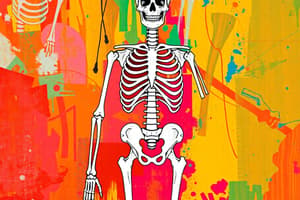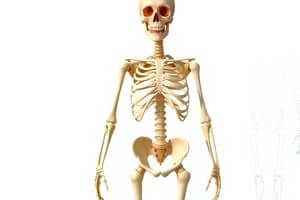Podcast
Questions and Answers
Which of the following is NOT a term for a rounded depression on the surface of a bone?
Which of the following is NOT a term for a rounded depression on the surface of a bone?
- Fovea
- Pit
- Impression
- Notch (correct)
What is the term for an elongated depression on the surface of a bone?
What is the term for an elongated depression on the surface of a bone?
- Notch
- Fossa
- Fovea
- Sulcus (correct)
Which term describes a depression located specifically on the border of a bone?
Which term describes a depression located specifically on the border of a bone?
- Fossa
- Fovea
- Notch (correct)
- Fissure
Which of the following statements about the periosteum is false?
Which of the following statements about the periosteum is false?
Which structure does NOT attach to the periosteum?
Which structure does NOT attach to the periosteum?
What is the total number of bones in an adult human skeleton?
What is the total number of bones in an adult human skeleton?
Which statement about the human skeleton is incorrect?
Which statement about the human skeleton is incorrect?
Which of the following is not a bone in the axial skeleton?
Which of the following is not a bone in the axial skeleton?
Which structure ossifies in the membrane?
Which structure ossifies in the membrane?
Which of the following bones does not ossify in cartilage?
Which of the following bones does not ossify in cartilage?
Which of these statements about the clavicle is false?
Which of these statements about the clavicle is false?
Which statement about compact bone is incorrect?
Which statement about compact bone is incorrect?
Which of the following is NOT a characteristic of long bones?
Which of the following is NOT a characteristic of long bones?
Which statement about short bones is accurate?
Which statement about short bones is accurate?
What is not a characteristic of flat bones?
What is not a characteristic of flat bones?
Which of the following bones does not ossify from cartilage?
Which of the following bones does not ossify from cartilage?
Sesamoid bones are typically found in which anatomical location?
Sesamoid bones are typically found in which anatomical location?
Which characteristic does not belong to sesamoid bones?
Which characteristic does not belong to sesamoid bones?
Which tendon is incorrectly associated with sesamoid bones in the upper limb?
Which tendon is incorrectly associated with sesamoid bones in the upper limb?
Which of the following options does not describe a regular elevation of bones?
Which of the following options does not describe a regular elevation of bones?
Which of the following functions of the periosteum is not true?
Which of the following functions of the periosteum is not true?
Which of the following terms is not classified as an irregular elevation of bones?
Which of the following terms is not classified as an irregular elevation of bones?
What part of the bone is primarily responsible for growth in length?
What part of the bone is primarily responsible for growth in length?
Where is the epiphyseal cartilage located?
Where is the epiphyseal cartilage located?
At what stage is red bone marrow present in all types of bones?
At what stage is red bone marrow present in all types of bones?
When does the yellow bone marrow fill all the medullary cavities of long bones?
When does the yellow bone marrow fill all the medullary cavities of long bones?
Which long bone is characterized by the absence of a medullary cavity?
Which long bone is characterized by the absence of a medullary cavity?
Which structure is NOT supplied by the nutrient artery?
Which structure is NOT supplied by the nutrient artery?
What components make up the blood supply of long bones?
What components make up the blood supply of long bones?
Which of the following statements about cartilage is NOT true?
Which of the following statements about cartilage is NOT true?
Which statement about hyaline cartilage is NOT true?
Which statement about hyaline cartilage is NOT true?
Flashcards are hidden until you start studying
Study Notes
Number of Bones in the Human Skeleton
- An adult human skeleton typically has 206 bones.
- The number of bones changes throughout a person's life, increasing during childhood and adolescence and decreasing with age due to bone fusion.
- The upper limbs contain 62 bones in total.
- There are 34 single bones and 86 paired bones in an adult skeleton.
Types of Bones and their Ossification
- Bones are classified into several types based on their shape and structure:
- Long bones (e.g., femur, humerus)
- Have a shaft (diaphysis) and two expanded ends (epiphyses).
- The shaft contains a medullary cavity filled with bone marrow.
- They typically ossify in cartilage.
- Short bones (e.g., carpals, tarsals)
- Are cubical or scaphoid in shape.
- Have three or four articular surfaces.
- They ossify in cartilage.
- Flat bones (e.g., skull bones, ribs, sternum)
- Consist of two lamellae of compact bone with a spongy layer between them.
- Most ossify in membrane, except for the sternum and ribs which ossify in cartilage.
- Irregular bones (e.g., vertebrae, facial bones)
- Have complex shapes and do not fit into the other categories.
- They can ossify in cartilage or membrane.
- Sesamoid bones (e.g., patella)
- Are small, round bones embedded in tendons or ligaments.
- They ossify in cartilage.
- Long bones (e.g., femur, humerus)
- Some bones exhibit mixed ossification, meaning they are formed by a combination of cartilage and membrane ossification.
- Bones of the base of the skull, bones of the face, and the mandible are examples of this mixed ossification.
- The clavicle is an irregular bone that also undergoes mixed ossification.
Bone Structure and Composition
- Compact bone
- Is hard and ivory-like.
- Forms the cortical covering of all types of bones.
- Forms the shaft of long bones.
- Resists bending and twisting by compression forces.
- Does not contain bone marrow.
- Cancellous bone (also known as spongy bone)
- Is formed of a trabecular meshwork (interconnected beams of bone).
- Contains spaces filled with bone marrow.
- Forms the interior of all types of bones.
- Is covered by compact bone.
- Does not form the shaft of long bones.
Features of Bones
- Elevations:
- Rounded elevations: Head, Condyle, Trochlea, Capitulum
- Irregular elevations: Tubercle, Tuberosity, Trochanter
- Linear elevations: Line, Lip, Crest, Ridge
- Depressions:
- Rounded depressions: Pit, Fovea, Impression, Fossa
- Elongated depression: Sulcus
- Depression on the border of a bone: Notch
Periosteum
- The periosteum is a fibrous membrane that covers the outer surface of all bones, except the articular surfaces.
- It is adherent to the bone by Sharpey's fibers.
- It is innervated and sensitive.
- Contains an outer fibrous layer and an inner cellular layer.
- Nourishes the outer part of the bony cortex.
- Is responsible for bone growth in thickness.
- Receives attachments from the joint capsule, tendons of muscles, ligaments, and fascial septa.
Bone Growth
- Growth in length of bones is due to the activity of the epiphyseal cartilage.
- The epiphyseal cartilage is located between the epiphysis and the metaphysis.
- As the epiphyseal cartilage grows, it is replaced by bone, leading to the lengthening of the bone.
- Growth in thickness of bones is due to the activity of the periosteum.
Bone Marrow
- Red bone marrow is the main site of blood cell production.
- It is present in all types of bones at birth.
- Over time, it is gradually replaced by yellow bone marrow in the medullary cavities of long bones.
- Yellow bone marrow is primarily composed of fat cells.
Blood Supply of Bones
- Nutrient artery: Supplies the medullary cavity, bone marrow, metaphysis, and the deep 2/3 of the compact cortex of the shaft.
- Periosteal arteries: Supply the outer 1/3 of the bone cortex.
- Metaphyseal arteries: Supply the metaphysis.
- Epiphyseal arteries: Supply the epiphysis.
Cartilage
- Cartilage is a non-vascular and insensitive connective tissue that provides support and flexibility.
- Articular cartilage is found at the ends of bones where they form joints. It is not covered by perichondrium.
- Repair of injured articular cartilage is difficult due to its avascular nature.
Hyaline Cartilage
- Hyaline cartilage is the most common type of cartilage.
- It is homogenous, bluish-white in color, translucent, and rich in collagenous fibers.
- It is liable to calcification.
Special Features of Bones
- The clavicle is the only long bone that does not have a medullary cavity.
- The patella (kneecap) is a sesamoid bone located in the tendon of the quadriceps femoris muscle.
Studying That Suits You
Use AI to generate personalized quizzes and flashcards to suit your learning preferences.




